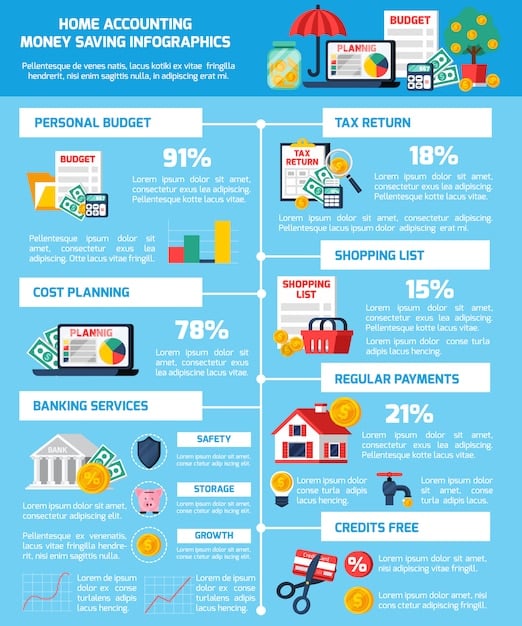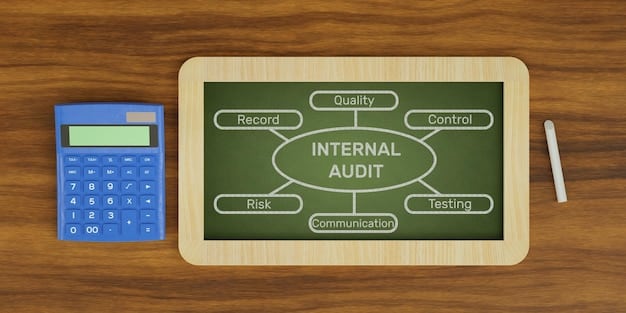Maximize Your Savings: Tax Benefits for Small Business Owners

Tax benefits for small business owners enable significant savings through deductions and credits, reducing overall tax liability and freeing up capital for reinvestment into the business.
Navigating the complexities of tax season can be daunting for small business owners. However, understanding and leveraging available tax benefits for small business owners can significantly reduce your tax burden and boost your bottom line. This guide will explore key deductions and credits to claim.
Understanding Tax Deductions for Small Businesses
Tax deductions are expenses that can be subtracted from your gross income to reduce your taxable income. For small business owners, identifying and claiming all eligible deductions is crucial for minimizing tax liabilities.
Here are some common tax deductions that small business owners should be aware of:
Home Office Deduction
If you use a portion of your home exclusively and regularly for business, you may be able to deduct expenses related to that space. This can include mortgage interest, rent, utilities, insurance, and depreciation.
Business Expenses
Ordinary and necessary expenses directly related to your business are generally deductible. This includes costs like office supplies, advertising, professional fees, and business travel.
Here are some specific examples of deductible business expenses:
- Advertising and Marketing: Costs associated with promoting your business, such as online ads, print materials, and website development.
- Business Insurance: Premiums paid for various business insurance policies, including liability, property, and workers’ compensation.
- Professional Fees: Payments to accountants, lawyers, consultants, and other professionals providing services to your business.
Understanding these deductions can substantially lower your taxable income, freeing up funds to invest back into your company.

Self-Employment Tax and How to Deduct It
Self-employed individuals are responsible for paying both the employer and employee portions of Social Security and Medicare taxes. However, you can deduct one-half of your self-employment tax from your gross income.
Understanding self-employment tax is vital for accurately calculating your tax obligations.
Calculating Self-Employment Tax
Self-employment tax consists of Social Security and Medicare taxes. The Social Security portion is 12.4% on earnings up to a certain limit (e.g., $147,000 in 2022), and the Medicare portion is 2.9% on all earnings.
Deducting Self-Employment Tax
You can deduct one-half of your self-employment tax, which is calculated on Schedule SE (Form 1040). This deduction is an above-the-line deduction, meaning you can claim it even if you don’t itemize.
Key points to remember about deducting self-employment tax:
- It reduces your adjusted gross income (AGI), which can impact your eligibility for other deductions and credits.
- The deduction is for one-half of the self-employment tax, not one-half of your self-employment income.
- Accurately calculating and deducting this tax can lead to significant savings.
Properly handling self-employment tax can result in considerable tax savings for your small business.
Claiming the Qualified Business Income (QBI) Deduction
The Qualified Business Income (QBI) deduction allows eligible self-employed individuals and small business owners to deduct up to 20% of their qualified business income. This deduction can significantly reduce your tax liability.
Let’s delve into the details of the QBI deduction:
Eligibility for the QBI Deduction
The QBI deduction is available to eligible self-employed individuals, small business owners, and owners of pass-through entities like S corporations, partnerships, and LLCs. However, certain limitations apply based on your taxable income.
Calculating the QBI Deduction
To calculate the QBI deduction, you generally multiply your qualified business income by 20%. However, the deduction may be limited based on your taxable income and the type of business you operate.
Limitations on the QBI Deduction
Higher-income taxpayers may face limitations on the QBI deduction. For example, if your taxable income exceeds certain thresholds, the deduction may be limited to 50% of your W-2 wages or 25% of your W-2 wages plus 2.5% of the unadjusted basis of qualified property.
Important considerations regarding the QBI deduction include:
- Understanding the income thresholds and limitations.
- Properly calculating your qualified business income.
- Consulting with a tax professional to ensure you maximize your deduction.
Maximizing the QBI deduction can substantially lower your taxable income, providing significant tax relief.

Tax Credits for Small Business Owners
Tax credits directly reduce the amount of tax you owe, providing a dollar-for-dollar reduction in your tax liability. Several tax credits are available to small business owners, offering valuable opportunities to save on taxes.
Here are some important tax credits for small business owners:
Research and Development (R&D) Tax Credit
If your business engages in qualified research and development activities, you may be eligible for the R&D tax credit. This credit can help offset the costs of innovation and development.
Work Opportunity Tax Credit (WOTC)
The Work Opportunity Tax Credit incentivizes employers to hire individuals from certain target groups, such as veterans, individuals receiving public assistance, and ex-felons. By hiring qualified individuals, you can earn a tax credit.
Credit for Increasing Research Activities
Many businesses don’t realize they qualify for this. It isn’t just for lab coats and test tubes. Do you develop new products, processes, or even software? The costs associated with these activities could yield significant tax credits.
Key benefits of tax credits include:
- Direct reduction of your tax liability.
- Incentives for specific business activities, like hiring and R&D.
- Potential for substantial tax savings.
Carefully assess your eligibility for various tax credits, as they can provide significant tax savings for your business.
Depreciation and Amortization for Business Assets
Depreciation and amortization allow you to deduct the cost of business assets over their useful lives. Understanding these concepts is essential for managing your business’s finances and reducing your tax burden.
Let’s explore depreciation and amortization in detail:
Understanding Depreciation
Depreciation is the process of allocating the cost of tangible assets, such as equipment, vehicles, and buildings, over their useful lives. You can deduct a portion of the asset’s cost each year until it is fully depreciated.
Understanding Amortization
Amortization is similar to depreciation but applies to intangible assets, such as patents, trademarks, and software. The cost of these assets is deducted over a specified period, typically 15 years for certain intangibles.
Methods of Depreciation
Several methods can be used to calculate depreciation, including the straight-line method, the declining balance method, and the modified accelerated cost recovery system (MACRS). The choice of method can impact the amount of depreciation you deduct each year.
Here are some important things to know about depreciation and amortization:
- They allow you to recover the cost of business assets over time.
- Properly calculating and claiming depreciation and amortization can reduce your taxable income.
- Consult with a tax professional to determine the best depreciation methods for your business.
Strategically managing depreciation and amortization can enhance your business’s financial health and reduce your tax obligations.
Strategies for Maximizing Tax Benefits
To maximize your tax benefits for small business owners, it’s crucial to plan ahead and stay organized. Here are some strategies to consider:
Effective tax planning can make a significant difference in your business’s bottom line.
Keep Accurate Records
Maintain detailed records of all income and expenses. This will make it easier to identify deductions and credits and support your tax filings. Use accounting software or hire a bookkeeper to help manage your financial records.
Plan Ahead
Meet with a tax professional early in the year to discuss tax planning strategies. This will give you time to implement strategies and make adjustments as needed. Consider estimated tax payments to avoid penalties.
Take Advantage of Retirement Plans
Contribute to a retirement plan, such as a SEP IRA or Solo 401(k). These contributions are often tax-deductible and can help you save for retirement while reducing your current tax liability.
Key takeaway points for maximizing tax benefits:
- Consistent and accurate record-keeping.
- Proactive tax planning with a professional.
- Strategic use of retirement plans and other tax-advantaged accounts.
By implementing these strategies, you can effectively reduce your tax liability and improve your business’s financial performance.
| Key Benefit | Brief Description |
|---|---|
| 🏡 Home Office Deduction | Deduct expenses for the portion of your home used exclusively for business. |
| 💼 QBI Deduction | Deduct up to 20% of qualified business income, subject to certain limitations. |
| 🔬 R&D Tax Credit | Receive a credit for qualified research and development activities. |
| 🤝 WOTC | Get a tax credit for hiring individuals from targeted groups. |
Frequently Asked Questions (FAQ)
▼
The home office deduction allows you to deduct expenses related to a portion of your home used exclusively and regularly for business, such as mortgage interest, rent, and utilities.
▼
Self-employment tax includes Social Security and Medicare taxes. Calculate it using Schedule SE (Form 1040), and remember you can deduct one-half of it from your gross income.
▼
The QBI deduction allows eligible small business owners to deduct up to 20% of their qualified business income, subject to certain limitations based on taxable income.
▼
Common tax credits include the Research and Development (R&D) Tax Credit and the Work Opportunity Tax Credit (WOTC), which incentivize specific business activities and hiring practices.
▼
Maintaining detailed records is essential for identifying deductions and credits, supporting your tax filings, and ensuring compliance with tax laws, helping to minimize your tax liability.
Conclusion
Understanding and leveraging tax benefits for small business owners is essential for reducing your tax burden and improving your business’s financial health. By staying informed and planning ahead, you can maximize your savings and reinvest in your business’s growth.





